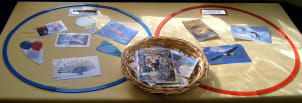The child sorts pictures of living and non-living things into two sorting circles.
Learning about living & non-living things

Aim
The child can identify living & non-living things and their characteristics.
Objectives
Develop:
- attention skills
- reasoning skills
Age
3½–4+
Materials
- 2 sorting circles
- 2 sets of pictures of both living and non-living things
- Basket/box
- Floor mat
Dialogue
This activity can be carried out in a small group of 4 or 5 children. Invite one of the children to lay the mat on the floor, and ask the group to sit with you around it. Place the basket containing the picture cards in the middle.
Ask each child to pick up a card, place it on the mat, and tell you what they see.
Start by telling the children that the world around us is filled with many things, and that we see so many things everywhere and every day: in the house, in the classroom, on the road, in the garden and in the park. Let the children think about things they see every day (chairs, birds, books, trees, flowers, cars etc.) Explain that animals, plants and people are living things. Things like schools, tables, chairs etc are man-made. These things are non-living.
Tell them that living things are different from non-living things. Allow time for children to think. You may give them hints and prompts and guide them step-by-step.
Provide them with simple concepts which they can easily grasp. For example, you might say: “All living things need to breathe to stay alive. People and many animals breathe through nose. Insects have tiny air holes in their body. Fish breathe though gills. Plants breathe through openings on their leaves.”
Non-living things do not have life, they do not breathe.
You might continue, saying: “All living things need food to carry out their activities. Animals and people need food to grow. Plants make their own food, they need water, sunlight and the soil. Plants can’t grow without light, water and air. Living things have sense organs (eyes, nose, tongue, skin and ears) that they use to respond to changes in their environment. Animals also feel and respond to changes in their environment. Non-living things do not feel. They are not affected by any changes around them.”
Remove the cards from the mat and put them back in the basket. Place the folding sorting circles on the mat and tell the children that you are going to sort the pictures into living and non-living groups. Select two pictures, one for each category, and place them within the corresponding circles. Now let the children pick up a picture and place it inside the chosen circle.
Tips

“The teacher’s task is… to prepare and arrange a series of motives for cultural activity in a special environment made for the child.” —Maria Montessori in The Absorbent Mind
You may ask each child in turn to go around the room and find a non-living object.
You might wish to set up an activity on your interest table to help children enhance their learning on this theme and to encourage them to work with independence.
Asking open-ended questions helps children develop reasoning skills, such as: How can you tell if something is living or non-living? What are some things that all living things have in common?